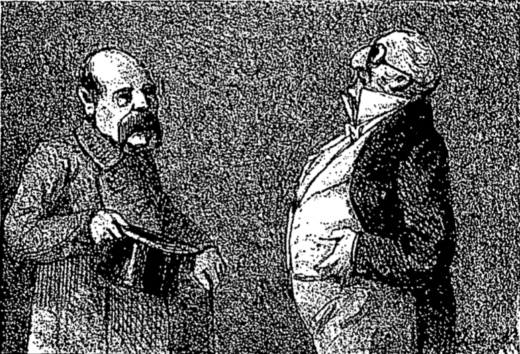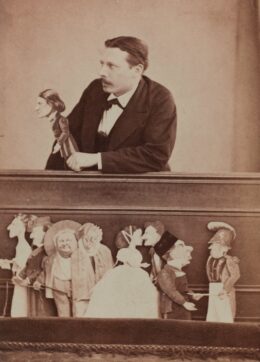
Printed
12 pages
Author(s)
Mon village
The play Mon village (My village) is part of the volume Paris-Pantin : deuxième série des “Pupazzi” (Paris-Puppet: second instalment of the “Pupazzi”) published in 1868. In this book, the plays are preceded by several prologues, often improvised by Lemercier de Neuville before his performances.
As was the case in the two instalments of the first Pupazzi series (1866), the author creates his texts from contemplations on his time, portraits of personalities and accounts of recent events; the characters and actions in Mon village allude to different historical events. For instance, the conflict between peasants and landowners echoes the expansion of Prussia and the international crisis caused by France’s attempt to annex Luxembourg. References to military weapons are also made [the “bâtons Chassepot” (Chassepot sticks) are a direct reference to the Chassepot rifle used by the French army in 1866], and the conflict around the vicar’s presbytery could symbolise the tension between the Catholic Church and the Second Empire at a time when the latter gave military support to Italy and thus contributed to the loss of a majority of the Papal States by the Holy See.
Monsieur Prudhomme is an emblematic character created by Henry Monnier (1799-1877), a French illustrator, caricaturist, and playwright. This character is a satire of the bourgeois man of Monnier’s time, symbolising the pretentiousness, rigid morality and conservative mind of the bourgeoisie during the first half of the 19th century.
A landlord must deal with different conflicts in the neighbourhood
M. Prudhomme is the owner of a village called Terrevieille (Oldland) where he lives with his faithful servant Gazette and his neighbour Annexmann. One day, Gazette advises him to build walls around his garden and to arm the inhabitants of his land because other peasants are equipped with stakes. M. Prudhomme commands her to find out the culprit, and Gazette leaves, seeking information.
Meanwhile Annexmann arrives to discuss a neighbour called Danois (Danish) and a parcel which used to belong to his ancestors. Fearing a conflict, M. Prudhomme decides to dig ditches and to arm his people.
Shortly after, Gazette comes back and informs her master that Annexmann’s men are carrying sticks with a needle on top whilst M. Prudhomme’s men have Chassepot rifles.
During the conversation, we learn of a new problem: a certain Victor had promised to respect the presbytery of the village’s vicar that is located in his orchards. However, Victor is now threatening to evict the vicar from his land. M. Prudhomme is outraged by this situation and, with Gazette, decides to defend the vicar’s house.
In return for her precious help, Gazette asks M. Prudhomme for a very special reward: freedom.
First performance
Au Cercle de la Société des Courses
Publications and translations
Lemercier de Neuville, Paris pantin : deuxième série des "Pupazzi", Paris : A. Lacroix, Verboeckhoven, 1868.
